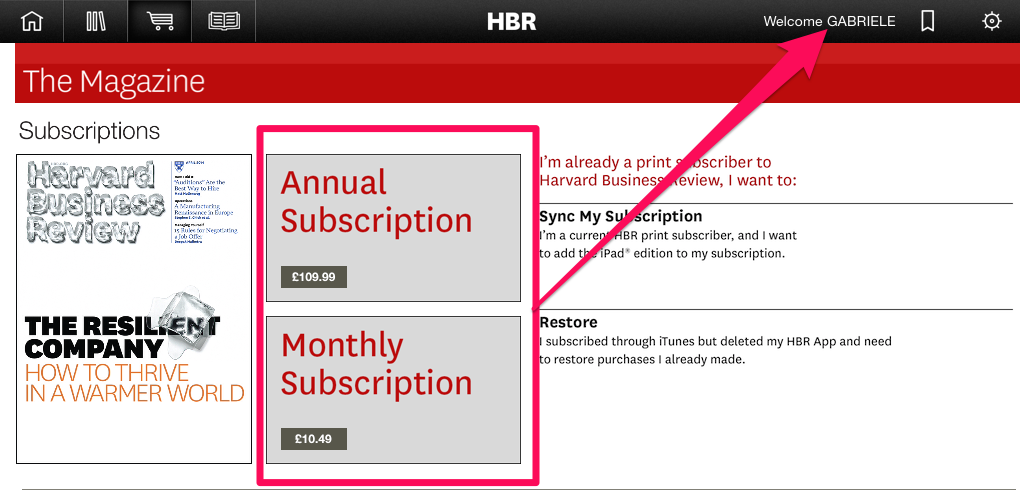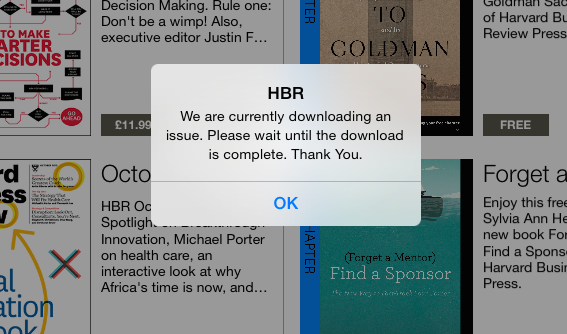After an early wave of magazine-apps when the iPad was launched we’ve now been mostly left to mediocre or down right bad user experiences in these types of apps. No wonder they haven’t been successful. The example I’ll expand on here is the Harvard Business Review (HBR).
Let’s get the first point straight: I love the HBR content. Occasionally they fall victim to latest an hippest management fad, but many of the articles are thought provoking and are sometimes directly applicable to my work. But boy is the iPad app bad!
It starts with registering your subscirption with the HBR app. If you didn’t buy the subscription through the Apple App Store you’ll have to enter your login credentials from the hbr.org website. Nothing earth shattering here, the registration flow is just ugly and complicated. But much worse: when you’ve logged in and authenticated in the app, it still wants you to subscribe to HBR with the App Store’s in-app purchase.

Wait: I’ve already paid, I’ve already registered my subscription and I’m logged in! Why can’t this whole area where the app asks my to either buy a subscription or sync it with my subscription bought through hbr.org just disappear? No idea…
But you might say, just get used to and ignore it. But it doesn’t stop there, obviously. Next up: try downloading an issue, more precisely download several issues at once. Not possible. Oh, you want to download an issue (or several of them) in the background while you do something more useful on than watching the progression of the download progress bar? Out of luck, background download not supported.

Surely once you’ve downloaded an issue and you start to read, it gets better, right? No way, we’re just getting started in the magazine-app from hell. The worst problem with the app is, that it doesn’t remember where you stopped last time you’ve been reading in the digital magazine. Imagine the following very common situation: in the morning during your commute to work you read an interesting HBR-article. Your train arrives to the station, you get to work and on the ride back in the evening you’d like to continue reading exactly where you’ve left in the morning. HBR doesn’t think you should be able to. The app restarts from scratch – especially if you’ve been using a bunch of other apps during the day – and you find yourself on the “home” tab, a collection of the latest online content from HBR. The following steps are then necessary:
- Navigate to the library
- Open the right issue
- Find the article you were reading
- Scroll to the position where you’ve stopped reading in the morning
As a bonus all of this is achieved with quite some lag between each step because the app is sooo slooow. And this is still not it. Below you’ll find a short and certainly not exhaustive list of further shortcomings:
- The app is slow to load issues and each page seems to be rendered from an image
- Each page being an image has some more drawbacks:
- No way to adjust size of the font
- No night reading mode
- No way to higlight text or add comments to interesting passages in the content – something that the Kindle or iBooks app allow you to do by default
In short: this app has all the shortcomings of an app that follows the print process instead of being a real digital issue. You can feel that the app is an afterthought in the process of producing the print magazine. Somebody just threw a plugin into the print layout software that automagically converts the print issue into a supposedly “digital” issue with little to no advantage compared to a simple & dumb pdf-file.
Digital magazines have to die in their current form and need to morph into a more digitally native format.
There are others though doing it right. Funnily one of them is nothing more than a marketing vehicle for the best known strategy consultancy: The McKinsey Insights iPad app. It’s a light weight app that delights the user with smooth animations when swiping from page to page and which makes the online content available offline with a reading list featurethat is available for each article individually. Snippets of the articles can be copied to the digital notebook of your choice and the font sizes can be adjusted. No highlighting and comments yet – but given the regular updates I’m confidentn that this will come at some point, too.
Digital magazines have to die in their current form and need to morph into a more digitally native format. It’s better to take the content from the online site into a nicely and dynamically presented app than having mostly static issues in a magazine app that is an afterthought of the print process. The redesigned and responsive hbr.org website is a first step. But alas, it comes with its own challenges. But that’s a post for another day.



